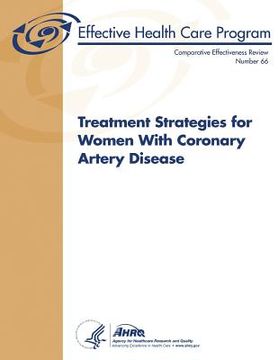Treatment Strategies for Women With Coronary Artery Disease: Comparative Effectiveness Review Number 66 (en Inglés)
Reseña del libro "Treatment Strategies for Women With Coronary Artery Disease: Comparative Effectiveness Review Number 66 (en Inglés)"
Cardiovascular disease remains the leading cause of death among women in the United States. More than 500,000 women die of cardiovascular disease each year, exceeding the number of deaths in men and the next seven causes of death in women combined. This translates into approximately one death every minute. Coronary artery disease (CAD)-which includes coronary atherosclerotic disease, myocardial infarction (MI), acute coronary syndrome, and angina-is the most prevalent form of cardiovascular disease and is the largest subset of this mortality. An estimated 16.3 million Americans 20 years of age and older have CAD, and the overall CAD prevalence is 7 percent in adults in the United States (8.3% for men, 6.1% for women). The prevalence of CAD is higher in men than in women across different age groups until they reach 75 years of age, giving the perception that CAD is a male-specific disease. This report focuses on women because of the differences in clinical presentation and coronary anatomy, which affect the treatment options for CAD. Currently available guidelines and systematic reviews provide specific treatment recommendations for women only among a subset of treatment options and overall assume that treatment options are equally effective for both sexes when gender data are not available. However, women have a worse prognosis than men for manifestations of CAD such as acute myocardial infarction, and some data suggest that women and men do not respond equally to the same treatments. Further, women are more likely than men to experience bleeding complications. In women, CAD is misdiagnosed or not treated as aggressively as in men or is under researched. Multiple factors are likely to contribute to the lower use of evidence-based medicine (medical therapy and/or coronary revascularization) and the higher rate of cardiovascular complications among women with CAD. These factors include: Cardiovascular disease affects women later in life; At the time CAD is diagnosed, women are more likely to have comorbid factors such as diabetes mellitus, hypertension, hypercholesterolemia, peripheral vascular disease, and heart failure; Women present with angina-equivalent symptoms such as dyspnea or atypical symptoms more often than men; The coronary vessels in women tend to be smaller than those of men, which makes them more difficult to revascularize percutaneously and surgically, and microvascular disease of the coronary arteries is more common in women than in men; Women tend to have less extensive CAD and a higher proportion of nonobstructive CAD; Delay in hospitalization, symptom pattern and recognition, and higher frequency of nonobstructive CAD ultimately results in delay in diagnosis and effective treatment; Because of underrepresentation of women in randomized controlled trials (RCTs), a lack of solid data on cardiovascular disease in women leaves uncertainty about the risk-benefit ratio of treatment. Thus, a better understanding of the evidence for the effectiveness of medical treatment and revascularization therapies specifically in women is needed in order to reduce cardiovascular events in women. Although CAD is the leading cause of death for women in the United States, treatment studies to date have primarily enrolled men and may not reflect the benefits and risks that women experience. We conducted this systematic review of the medical literature to assess the comparative effectiveness of the major treatment options for CAD specifically in women, evaluating these comparisons: 1. PCI versus fibrinolysis or PCI versus conservative/supportive medical management in women with STEMI; 2. Early invasive versus initial conservative management in women with UA/NSTEMI; 3. PCI versus CABG versus optimal medical therapy in women with stable or unstable angina. The endpoints assessed were clinical outcomes, modifiers of effectiveness by demographic and clinical factors, and safety outcomes.

